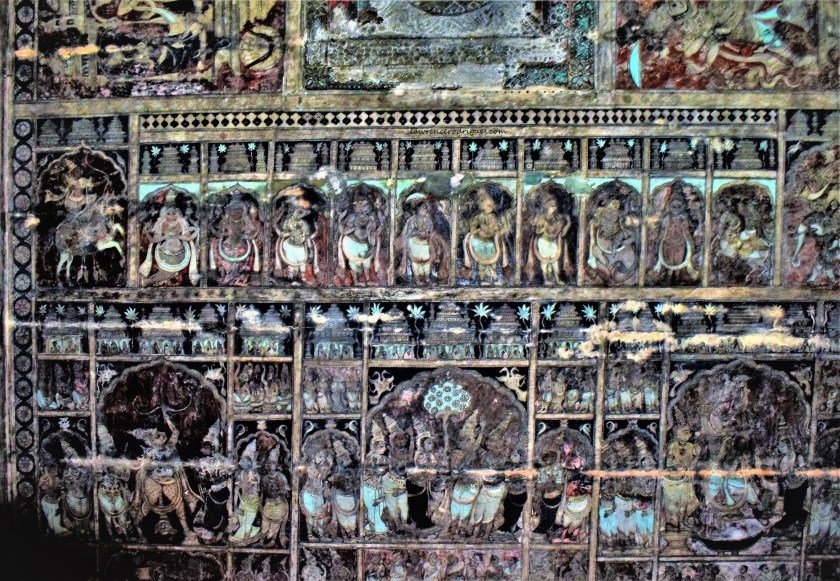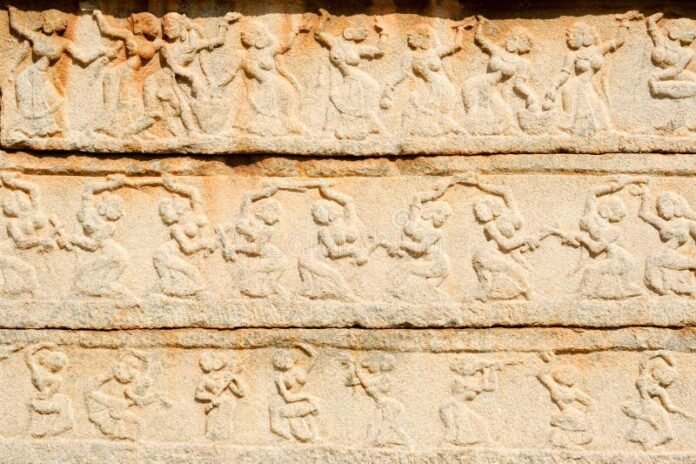Hampi art When you walk through the boulder-strewn landscape of Hampi art, it feels like time has paused. But it hasn’t. It’s speaking to you—in whispers carved in stone and painted on weathered temple walls. The Painted Temples of Hampi are not just remnants of a glorious empire; they are visual poems, artistic sermons, and mythological masterpieces that tell us who we once were.
In this blog, we take you on a vivid journey through the temples of Hampi, unearthing the stories etched in color and carved in granite, bringing alive the art that speaks, quite literally.
🛕 Hampi: A Living Canvas of Stone and Color

Hampi, located in the southern state of Karnataka, India, was the capital of the Vijayanagara Empire in the 14th century. Today, it is a UNESCO World Heritage Site, attracting thousands of art lovers, historians, and spiritual seekers. While most visitors are mesmerized by its towering gopurams and monolithic sculptures, few notice the delicate paintings—faded but not forgotten—that adorn its ceilings, pillars, and sanctums.
These painted relics tell us not just stories from Hindu epics like the Ramayana and Mahabharata, but also give us a glimpse into daily life, royal court scenes, musical traditions, and ancient fashion. This is art as documentation, celebration, and spiritual devotion—all rolled into one.
🎨 The Forgotten Frescoes of the Virupaksha Temple

One of the most remarkable repositories of painted art in Hampi is the Virupaksha Temple. Though it still functions as a place of worship, it also serves as a museum of ancient brushstrokes. The ceiling of the Ranga Mandapa (main hall) is adorned with exquisite murals that have survived time, weather, and invasions.
Painted using natural mineral pigments—sourced from rocks, flowers, and herbs—these artworks depict gods and goddesses, celestial musicians, and episodes from sacred texts. The frescoes are often outlined with precision, filled with earthy reds, saffron yellows, and mystical blues.
One particularly striking mural shows Lord Shiva and Parvati seated on Mount Kailash, while celestial beings float around them. Despite centuries of wear, their expressions remain tender and divine, as if painted yesterday.
🧱 Sculpted Art That Complements Painted Mastery
While the paintings are the soul of Hampi’s temples, the stone carvings are their skeleton and muscle. Temples like Hazara Rama, Achyutaraya, and Vittala Temple boast friezes and pillars that capture motion—dancers mid-spin, warriors mid-strike, and kings mid-procession.
Interestingly, in some shrines, painted figures overlap or interact with sculpted ones, creating a multi-layered storytelling effect. This blending of mediums—stone and paint—is rarely seen in other parts of India with such finesse.
📜 Themes: Myth, Morality, and Mundane Life

The subjects of these paintings are vast:
- Divine Tales: Episodes from the Ramayana, Mahabharata, and Puranas dominate the walls. These are not just decorative—they were meant to teach, inspire, and humble.
- Royal Chronicles: Scenes showing royal durbars, marriage processions, and battle strategies reveal a peek into the Vijayanagara court’s life.
- Cultural Vibrancy: Look closely, and you’ll spot musicians with veenas, dancers in intricate poses, and commoners involved in daily chores—offering a visual anthropology of the 15th century.
The blend of spiritual narratives and secular records make the paintings an essential record of both divine and human dimensions of life.
🧪 The Science Behind the Paint
The colors used in Hampi’s temple paintings were not just beautiful; they were scientifically crafted. Ancient artists used:
- Red ochre from iron-rich soil
- Yellow from turmeric or yellow clay
- White from crushed shells and lime
- Black from soot or burnt coconut shells
- Blue from indigo and rare stones
These pigments were mixed with natural adhesives like resins and animal glue to make them long-lasting. In some places, you can still see hints of shine under flashlight—a testament to their skill.
🕊️ Destruction, Decay, and Silent Survival

The fall of the Vijayanagara Empire in the 16th century brought waves of destruction to Hampi. Invaders looted, temples were vandalized, and countless paintings were whitewashed or left to decay. Yet, some art survived—hidden in ceilings, shaded corridors, or beneath protective layers of dust.
In recent years, conservationists and archaeologists have worked meticulously to clean, protect, and restore these treasures. But many still lie in shadow, waiting for the curious eye of an art lover or historian to rediscover them.
🔗 Related Blog Post Suggestions (Bottom Section)
You May Also Like:
- 👉 The Artistic Spirit of Pushkar: Camels, Crafts & Canvas
- 👉 Manipurs Dance Meets Design: Classical Movement in Visual Art
- For More Details go to this Wikipedia Link
📣 Why Hampi Still Matters Today
In a world of digital art and AI-generated visuals, the hand-painted stones of Hampi remind us that Hampi art once required devotion, not just creativity. The temple walls echo the voices of ancient painters and sculptors who didn’t sign their names but signed their souls into every detail.
As you scroll through your social feed or stand in a museum, ask yourself—how many stones do you know that can speak?
In Hampi, they do.
🧠 Final Thoughts
If you love Hampi art, mythology, Indian culture, or simply discovering stories hidden in plain sight, the Painted Temples of Hampi deserve your time and attention. They are not just about gods and kings—they are about us, our collective past, and the beauty of expression carved in eternity.
